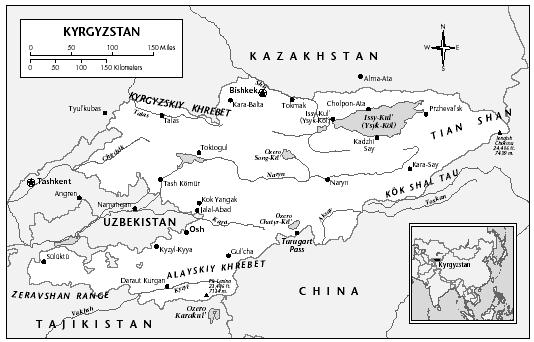History
The area of present-day Kyrgyzstan contains evidence of human habitation from the time of the Lower Paleolithic on, approximately 300,000 years ago. Archeologists suggest that two types of economies developed in the territory—farming and pastoral nomadism. By the 7th century BC nomadism had become predominant, and the area was controlled by various tribal alliances. In the north the Saki (7th–3rd centuries BC ) were succeeded by the Usuni (2nd century BC –5th century AD ); in the south the Parkan state (2nd–1st centuries BC ) was replaced by the Kushani kingdom (1st–4th century AD ). The ethnic identity of those peoples is the subject of much debate, but they were not Turkic. From the 6th century on, various Turkic tribes began to push westward, eventually settling most of Central Asia, including Kyrgyzstan. Much of present Kyrgyzstan was united by the 7th century as part of the West Turkic Kaganate, and replaced in the 8th century by the Turgash, who in turn were conquered by the Karluk, who originated in the Altai region further north.
When the present-day Kyrgyz first came to this territory is the subject of much debate. References to tribes of that name living in the Altai occur in the 10th century, but another people with the same name who lived along the Enisei River are first mentioned in records from the 2nd century BC . The Enisei Kyrgyz formed the Kyrgyz Kaganate in about AD 650, which survived until defeat by Genghiz Khan in 1209. Kyrgyz tradition prefers to see its origin in that state, but ethnographers and archeologists view the claim with considerable skepticism.
Evidence suggests instead that the present-day Kyrgyz are an amalgamation of various peoples, as existing tribes incorporated themselves into fresh waves of conquerors. The territory was part of the Karakhanid state from about 950–1150, during which the urban population was actively involved in trade and manufacturing along the Silk Road. Conversion to Islam also began in this period.
Genghiz Khan's Mongols conquered the area in the 13th century, destroying most of the Karakhanid culture and introducing large numbers of new peoples into the area, of Turkic, Mongol, and Tibetan stock. The resulting mix of tribes was almost certainly the basis for the present-day Kyrgyz people, who retain much of the memory of those origins in the orally preserved genealogies of their 40 clans and tribes. The present Kyrgyzstan flag includes the depiction of a sun with one ray for each tribe. The Kyrgyz follow Mongol practice of dividing their people into left ( ong ) and right ( sol ) "wings," said to reflect either the deployment of troops in military formation, or the tribe's original place of habitation. There is also a third group, the ichkilik, that seems to include parts of the Kyrgyz identity.
From the 15th century until the 17th century the Kyrgyz tribes were part of the larger delineation of Central Asian history, which distinguished agricultural sedents from pastoral nomads. The appearance of the same tribal names among Kazakhs, Kyrgyz, and Uzbeks suggests how the people of this territory formed a series of tribal alliances, rather than a true state.
In the 18th century the Kyrgyz began to come under pressure from Mongol tribes farther east. This prompted some of the northern tribes to send delegations to the Russians, who had pushed into Siberia in the 17th century, and who were beginning to take what is now northern Kazakhstan under its control. The Russians made no distinction between the Kazakhs and Kyrgyz, calling both Kyrgyz. The southern Kyrgyz, however, were conquered by the Kokand Khanate, established in the late 18th century, separating them from the northern Kyrgyz. This split between south and north continues to the present day in Kyrgyz life.
Russian expansion into what it called the Steppe included Kyrgyzstan. Most of northern Kyrgyzstan was incorporated into the empire by 1863; the south followed in 1876, when Russia destroyed the Kokand Khanate. Administratively, present-day Kyrgyzstan was split among four guberniias. Beginning in the 1890s Russia settled Russian and other European farmers into the fertile river valleys of the north, forcing Kyrgyz nomads higher into the mountains.

By 1916, Russia's policies of livestock requisition and land use had left the Kyrgyz badly impoverished. When Russia attempted to issue a draft call-up for Central Asian males, including the Kyrgyz, widespread fighting broke out all across the territory. The uprisings were suppressed, with great loss of life; population in the northern part dropped as much as 40%. Since independence in 1991, the state has commemorated the 1916 uprising as a genocide.
Hostility to the tsars meant that there was some support for the Bolsheviks, at least until it became clear that Lenin was not going to encourage the development of national states. Resistance to the Russians continued sporadically until the mid-1920s, in what Russian historians have labeled the Basmachi Rebellion.
Approximate extent of Scythia within the area of distribution of Eastern Iranian languages (shown in orange) in the 1st century BCHistorical map of Central Asia showing Kyrgyzstan (map circa 1885-1890)
Uyghur Princesses. Bezeklik, Cave 9, 9-12th century CE, wall painting, 66 x 57 cm. Located at the Museum für Indische Kunst, Berlin-Dahlem.
Map of the Tujue Khanate (Ashina clan of Göktürks) at its greatest extent in 570.





No comments:
Post a Comment